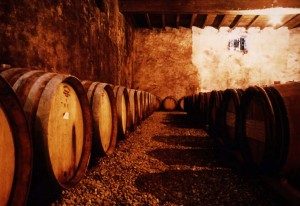Languedoc wines appellation Cabardès
Your campsite is located in the heart of the Cabardès vineyards, an AOC appellation covering 550 hectares of vines south of the Montagne Noire, close to your Le Martinet Rouge campsite. The soil is not very fertile, but is particularly well-suited to quality production.
Cabardès is the only wine that blends grape varieties of both Mediterranean and Atlantic origin: Merlot and Cabernet Sauvignon for the Atlantic, and Syrah and Grenache for the Mediterranean.

The dominance of strong winds from the Atlantic Ocean provides the maritime air that allows the Cabernet Sauvignon and Merlot grape varieties to flourish, giving this wine its characteristic taste, with structured tannins and aromas combining fruit such as blackcurrant and plum with notes of smoke and leather… while the southern grape varieties, which appreciate the sun, flourish in the warm, dry Mediterranean climate. On the nose, these crus give off scents of garrigue, spices and liquorice.
The Cabardès appellation, anAude wine to be enjoyed absolutely (in moderation!)
Cabardès wines
Cabardès, under the cross winds of east and west, takes on a singular balance, developing in its aroma all the sweetness of the Mediterranean with the vivacity of the ocean. Two AOC wines:
Cabardès red wines with a deep red color.
Nose: aromas of blackcurrant liqueur, black cherry, candied fruit, violet, leather.
Palate: velvety, powerful, complex.
Cabardès rosé wines in a wide range of colors.
Nose: intense, clean aromas of red fruit, raspberry, strawberry. Very tasty.
Palate: fruity, lively and typical. Beautiful roundness with crunchy fruit.
The confidentiality of the Caberdès AOC wine makes for good cohesion between wineries and producers.
The history of Cabardès wine
Introduced by Greek merchants in the 2nd century, wine production in the region really took off under Roman occupation.
But it was the monks of the abbeys of Lagrasse, Caunes-minervois, Fontfroide and Saint-Hilaire who drove viticulture forward.
The country embraced the Cathar religion, which authorized wine production in the region, but adherence to the dogma led to the destruction of vines by the soldiers of the Albigensian crusade, notably Henri de Beaujeu. Then came the Black Prince, who had what remained of the vineyards uprooted during his incusrion in Languedoc during the 100 Years’ War.
It wasn’t until the completion of the Canal du Midi in 1681, which linked the Mediterranean and the Atlantic, that modern vineyards were once again established and trade progressed. Two successive crises, one caused by powdery mildew and the other by phylloxera, led to a revolt by too many growers.
The winegrowers then organized themselves into a cooperative, prioritizing quality over quantity, and in 1999 obtained the AOC for Caberdès wines.
The AOC comprises 4 cooperative wineries and 18 private wineries, representing around 300 winegrowers. Many offer tasting cellars for the public to discover the quality of their vineyards, glass in hand.
Visit the Aude, a wine-growing region on the wine route
Cabardès is also a land to discover, just a few kilometers from Carcassonne, where old stones charm you in villages nestled at the foot of the Montagne Noire. Aragon, anchored on a rocky outcrop and surrounded by the Cabardès vineyards, offers a superb panoramic view of the region. The village of Montolieu offers a haven for book lovers, with its narrow streets lined with second-hand booksellers, bookshops and art craftsmen, as well as a Museum of Book Arts and Crafts.
Other walks for history buffs: the Château de Pennautier, the Vilelongue abbey, the Brousse paper mill or the drystone capitelles, the museum of old winegrowers’ tools.
Finally, the
Canal du Midi
is an invitation to silence and meditation in the midst of lush greenery, providing the perfect backdrop for sporting activities and hiking escapades… What a program!
Book your mobile home in Carcassonne – Your pitch in Aude
camping Cabardès, camping Aude




















